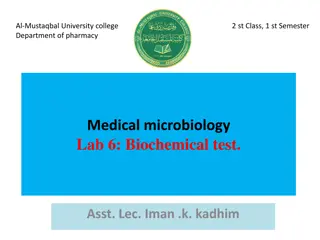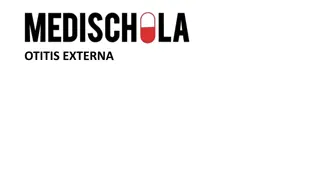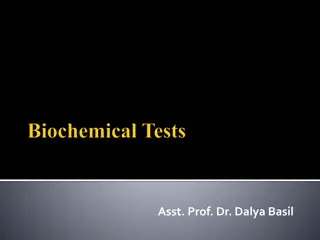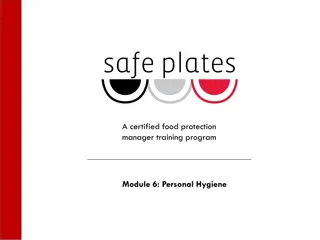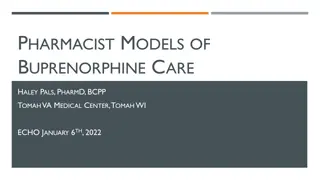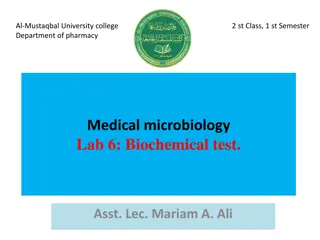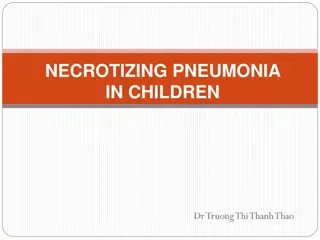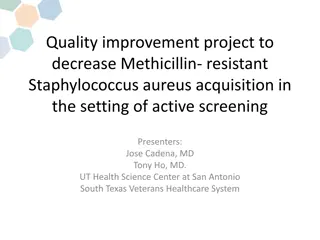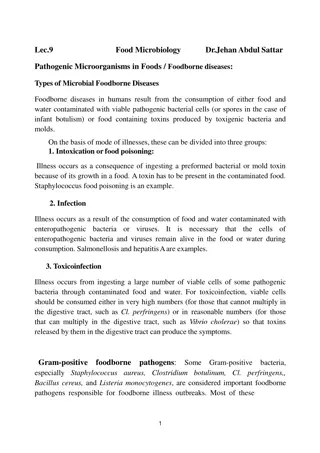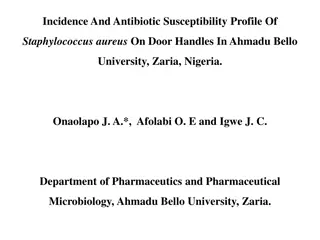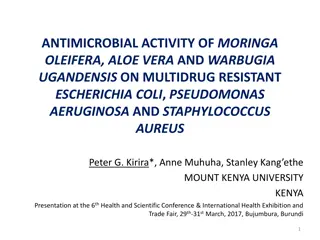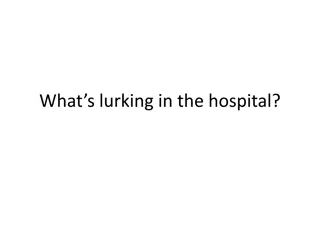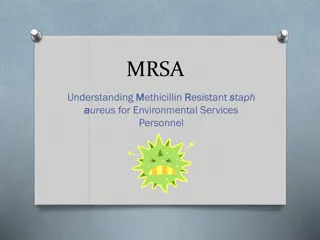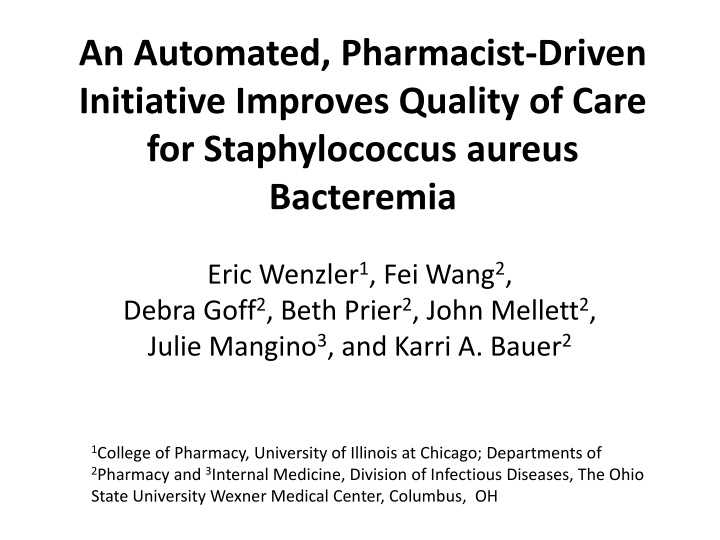
Automated Pharmacist Initiative Improves Care for Staphylococcus aureus Bacteremia
Study evaluates impact of automated pharmacist-driven initiative on patients with S. aureus bacteremia. Rationale, methodology, outcomes, conclusions, limitations, implications discussed.
Download Presentation

Please find below an Image/Link to download the presentation.
The content on the website is provided AS IS for your information and personal use only. It may not be sold, licensed, or shared on other websites without obtaining consent from the author. If you encounter any issues during the download, it is possible that the publisher has removed the file from their server.
You are allowed to download the files provided on this website for personal or commercial use, subject to the condition that they are used lawfully. All files are the property of their respective owners.
The content on the website is provided AS IS for your information and personal use only. It may not be sold, licensed, or shared on other websites without obtaining consent from the author.
E N D
Presentation Transcript
An Automated, Pharmacist-Driven Initiative Improves Quality of Care for Staphylococcus aureus Bacteremia Eric Wenzler1, Fei Wang2, Debra Goff2, Beth Prier2, John Mellett2, Julie Mangino3, and Karri A. Bauer2 1College of Pharmacy, University of Illinois at Chicago; Departments of 2Pharmacy and 3Internal Medicine, Division of Infectious Diseases, The Ohio State University Wexner Medical Center, Columbus, OH
Journal Club Format Issue being studied Rationale Study design and methodology Main outcomes Primary conclusions Study limitations Study implications Questions/discussion
Issue Being Studied The objective of this study was to evaluate the impact of an automated, pharmacist-driven targeted initiative for patients with S. aureus bacteremia (SAB).
Rationale All patients with SAB were not being optimally managed. We could do better. We should do better. The challenge was how? Mandate ID consults? Pharmacists manage 24/7? As ASPs develop, we need to explore ways to maximize program efficiency. Technological advances such as the electronic medical record (EMR) and clinical decision support systems (CDSS) allow ASPs to deliver more efficient patient care. Incorporating health informatics allows ASPs to more seamlessly integrate data from various sources to optimize patient outcomes.
Study Design and Methodology Design: Retrospective, quasi-experimental study. Subjects: All hospitalized adult inpatients with a blood culture positive for S. aureus. (Only first episode of SAB per patient analyzed.) Time frame: Pre-intervention period: January to March 2015 Intervention period: January to March 2016 Exclusions: included patients who: Were incarcerated. Received an ID consult prior to positive blood culture. Were transferred from an outside hospital with ongoing SAB on admission. Were discharged prematurely against medical advice.
Study Design and Methodology PRE-INTERVENTION Blood cultures: Standard analysis using RDT Verigene Gram positive blood culture (BC-GP) assay. Initial reporting: Laboratory personnel notified treating physician within 10 minutes (during both pre-intervention and intervention periods). Evidence-based practice guideline: Provided to clinicians for diagnosis and management of SAB. ASP evaluation: Case-by-case basis; no formal system- wide process to actively promote SAB quality-of-care measures.
Study Design and Methodology POST-INTERVENTION Pharmacist notification 24/7: Service-based pharmacists notified of BC-GP results every 15 minutes through use of patient scoring tool. Scoring tool: Developed by project team consisting of 3 informatics pharmacists and 2 ID pharmacists. Pharmacist action: Pharmacists required to review patient scoring tool list at least once per shift (during 3 8-hr shifts). All patients with SAB evaluated; verbal and written recommendations provided to treating physician via EMR, as needed.
Study Design and Methodology DATA AND OUTCOMES Data obtained: Age, sex, hospital service, wide range of comorbidities (including SAB in previous 90 days, source of SAB, SA methicillin susceptibility, and hospital or community SAB acquisition). Primary outcomes: Overall compliance and adherence to individual quality-of-care components: ID consult Repeat blood cultures Echocardiogram Initiation of SAB-targeted antimicrobial treatment (including time to initiation of targeted therapy)
Study Design and Methodology DATA AND OUTCOMES (cont.) Secondary Outcomes: Time to pharmacist intervention (difference between time BC-GP signaled positive for S. aureus and pharmacist documentation in EMR) Duration of bacteremia Length of hospital stay (LOS) Infection-related LOS 30-day readmission 30-day all-cause mortality
123 Patients Screened 38 patients excluded: Received ID consult prior to SAB (36) Duplicate encounters (2) Age >89 years (1) Pre-Intervention: 45 patients Intervention: 39 patients
Subject Assessment Demographics and baseline characteristics: Well matched between the 2 groups. SAB source and data: Catheter-related source most common. MRSA accounted for over half of SAB episodes. 2/3 and 3/4 of SAB occurrences were community- acquired in pre-intervention and intervention groups, respectively.
An Automated, Pharmacist-Driven Initiative Improves Quality of Care for Staphylococcus aureus Bacteremia Initiation of targeted antibiotics for SAB 40 hours sooner in intervention group ID consults Repeat blood cultures p 84% 100% P=0.01 75% 95% P=0.01 95% 100% P=0.49 Wenzler E, Wang F, Goff D, Prier B, Mellett J, Mangino J, Bauer K. Clin Infect Dis 2017
An Automated, Pharmacist-Driven Initiative Improves Quality of Care for Staphylococcus aureus Bacteremia Mortality 6 fold higher in pre-intervention Echocardiogram Overall compliance p 93% 92% 15% 2% P<0.06 92% 68% P<0.008 Clin Infect Dis 2017 Wenzler E, Wang F, Goff D, Prier B, Mellett J, Mangino J, Bauer K
Conclusion An automated, pharmacist-driven initiative significantly improved adherence to quality-of-care components for patients with S. aureus bacteremia. Implementation of a pharmacist-driven intervention in patients with SAB resulted in a significant increase in 1. number of patients receiving (not mandating) an ID consult 2. number of patients receiving targeted antibiotic therapy We accomplished this by leveraging frontline pharmacists without additional stewardship efforts
Study Limitations Use of retrospective design: led to inability to definitively assign causality for process measure compliance. Small sample size, single-center, non-randomized. Pharmacists only required to review patient scoring tool once per shift. Pharmacists did not record amount of time required to make recommendations and interventions, but workload seemed manageable. Large disparities noted in some clinical endpoints (eg, mortality) but not statistically significant, possibly owing to small sample size.
Study Implications First study to demonstrate impact of an automated, pharmacist-driven intervention for management of patients with SAB. Findings show that pharmacist engagement via the EMR can serve as a framework for providing more efficient, impactful, disease state-based patient care for SAB.


